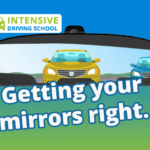During October 2010, the Driver and Vehicle Standards Agency (DVSA) introduced the independent driving element to the UK practical driving test.
The independent part of the driving test to enable the examiner to assess the candidates capability to drive separately, utilising road markings and road indications and with little input from the examiner.
With the update of the 2017 driving test modifications, the independent part has now increased from 10 minutes, to 20 minutes which is around half of the whole time of the driving test.
Another brand-new addition to independent driving is the inclusion of following directions from a sat nav. This section describes what occurs throughout the independent part of the driving test, plus ideas for finishing it effectively.
WHAT IS THE INDEPENDENT DRIVING TEST
From the 40 minutes duration of the practical driving test, 20 minutes are designated for independent driving. During the test, the examiner will ask you to park up on the left when it’s safe to do so and they will continue to tell you that the independent driving part will begin. You can more information on the test by checking out The complete guide on how to pass your driving test.
The independent driving section requires you to drive unaided from instruction by the examiner. Prior to the brand-new variation of independent driving, the examiner would require you to follow instructions from a diagram map. Diagram maps are no longer used for independent driving. In order to acquire instructions during independent driving for the brand-new driving test, there are 2 choices:
Following directions from a sat nav
Following directions from road signs
THE SAT NAV
From every 5 driving tests performed, 4 tests will include following instructions from a sat nav during independent driving. You don’t need to stress over bringing your own sat nav, the examiner will bring one. The sat nav that examiners use is a TomTom Start 52, which will be put on a Genius flat dash-mat. The sat nav will utilise an inbuilt battery as a source of power, so there’s no requirement for the examiner to plug in cables to your car.
The pupil will not operate the satnav as the examiner will setup the route on the sat nav – you’ll simply need to follow directions. You’ll not be given the option to use your own sat nav device.
ROAD SIGNS
If your driving test doesn’t involve the use of a sat nav, you’ll be required to follow road signs for the independent driving section. Independent driving routes where road indications are to be used will be plainly noticeable for test candidates. If you can not see a road traffic sign (this might be due to the fact that it’s covered by trees for example), the examiner will offer direction until the next indication is visible.
In the case for following road indications, the examiner will mention they would like you to follow the road signs to a specific area, they will then update you accordingly. If you are a little uncertain of where you need to be going, ask the examiner to repeat directions.
INDEPENDENT DRIVING RULES
There are no rules that you need to follow for independent driving. In fact, you do not even need to worry about following directions or indications correctly. Obviously try your best to keep to the right routes and instructions, but the primary function of the independent driving area is to demonstrate that you can remain safe and calm whilst driving unaided.
INDEPENDENT DRIVING WRONG TURN
Whether it’s following a sat nav or road signs, the most knowledgeable of drivers take a wrong turn in some cases. If this occurs throughout the test, do not stress as the sat nav will recalculate the path for you and put you back on track. If your test involves following road signs and you make a wrong turn, the inspector will assist you and put you back on path.
INDEPENDENT DRIVING FAIL
Numerous pupils ask “Can you fail the driving test for going the wrong way?” No, going the wrong way on a driving test will not fail you. What frequently does take place however, is that the pupil ends up being stressed out and makes mistakes that may then lead to a test failure. Read our top 10 reasons people fail their driving test.
What should I do if I go the wrong way on a driving test?
The examiner will be conscious of the error and will help you to get back on path. If you do end up being stressed out and overloaded, explain to the inspector that you wish to pull over for a moment to compose yourself.
LEARNING INDEPENDENT DRIVING
An experienced driving instructor can provide important practices for the independent driving section. They will know the sat nav routes local to you and the road sign routes that the examiners use and will provide preparation on both.
The instructor will discuss what is included for independent driving and will initially offer verbal assistance for both the sat nav and road sign versions. As you gain experience and self-confidence, the trainer will use much less verbal interaction so to replicate the real independent driving section of the driving test.
INDEPENDENT DRIVING TEST POINTERS
If you are not entirely sure of the directions you need to take, ask the examiner for help. This is naturally planned to be ‘independent’ so assist from the examiner may be restricted.
It makes no difference to the result of the driving test if you make wrong turns during the independent driving providing you do so safely.
If you feel that you are becoming excessively stressed (at any point throughout the driving test not just independent driving) pull over in a safe, legal and quiet location to take a couple of moments to compose yourself.
MAKING SAT NAV MODIFICATIONS
All DVSA examiners will use the TomTom Start 52 model sat nav during the test. This device is extremely adaptable and the examiner is able to alter the colour, contrast and volume to guarantee it appropriates for all test candidates.
The setup of the sat nav will in general be ‘default’ as it is the more suitable setting used for the majority of users, however if a test prospect requires the design changed on the device, the trainer should contact their Local Driving Test Supervisor before the test to discuss customised settings needed for the test candidate.
We hope you find this article on Independent driving useful in helping you pass and prepare for your driving test.






